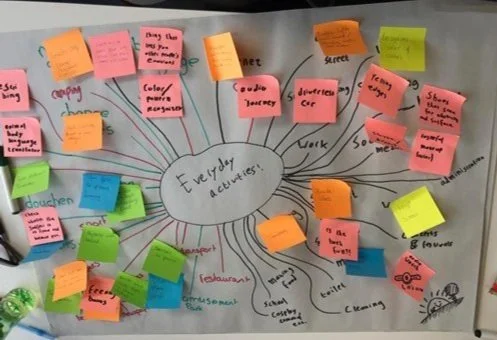Blindle
From Idea to Design: Course
I started the process of case selection with some brainstorming. At first I created a mind map for each case. In each mind map, I thought about things that we associated with the subject. These could be problems, daily habits, solutions etcetera. After that, I did some online research using the RTDP. I mostly made use of analyzing/abstracting and validating quality. As the brainstorming did not give me a clear perspective on how to do sensing and perceiving, I thought I could use this better in a later stage with a clearer idea. For analyzing and abstracting, I looked on the internet for current ideas, solutions and circumstances. Thereafter, I tried to validate quality by looking for numbers such as the number of people with a long term disease or the amount of pollution. Lastly, I looked into envisioning by thinking about what we value most. This guided me in favor of the health case.
We interviewed a blind man, to get to know what the difficulties of being blind are. We created a new mind map to go deep with different kinds of blindness. Using post-its we put ideas/solutions to the kind of blindness that they matched. However, we got a bit stuck. Therefore, we tried to put ourselves in the shoes of the blind by thinking about daily activities of our own, that a blind person might struggle with. Again we used post-its to put possible solutions on top of the found problems. It appealed to us that the social interaction is a subject that is hard for the blind and can be improved. So we did some role playing to find struggles for blind people while playing games. We also did some research in what kind of games already exist. Then we started sketching to gain more ideas.
In the end, me and my team created a prototype in the form of a board game, which can be played by blind/bad-sighted people together with people who can see.
Skills
User Testing (Interviews)
Prototyping
Ideation
Expertise Areas
User & Society
Technology & Realization
Creativity & Aesthetics





